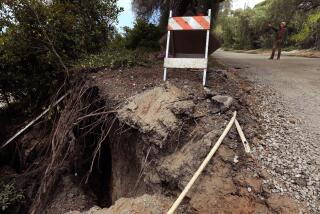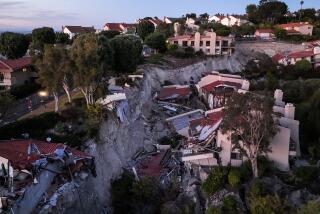Satellite Images Show Venus’ Surface Is Still Evolving
Scientists have finally found what they have been looking for in the thousands of images sent back by the Magellan spacecraft over the past year--convincing evidence that Venus, like the Earth, is still geologically alive.
The images show that sometime in the last few months, Venus had a massive landslide that was probably triggered by a “Venus quake.” Until the discovery, made Thursday night at the Jet Propulsion Laboratory in Pasadena, no one could say for sure whether Venus has dynamic, ongoing processes like those that have built mountains and filled valleys with debris on Earth.
Magellan, which is managed by JPL for the National Aeronautics and Space Administration, has been sending back sharp radar images of the surface of Venus for more than a year. But those have been static images, revealing the ground as it appeared at the moment the spacecraft passed overhead.
Earlier this year, Magellan began a second phase of mapping, passing over the same territory it had covered before and taking new images to see if anything had changed.
On Thursday night, Jeffrey J. Plaut, a planetary scientist who finished working on his doctorate just in time to join the Magellan project, was comparing images taken eight months apart of Venus’ Aphrodite Terra, a high, equatorial plateau. As he studied the two images, Plaut realized that one--taken last month--was quite different from one taken in November.
“Where there once was a plateau, there now is a pile of rubble,” he said during a hastily called news conference Friday at JPL.
Not quite certain what he was seeing, Plaut sensed that the slope of the plateau had been altered by a massive landslide that sent millions of tons of rock crashing into the valley below.
“I tried to remain calm,” he said. But Plaut soon found himself “running around screaming in the office.”
It was 6:30 p.m., and everybody else had gone home.
He continued studying the images, still not sure what they showed. Magellan is designed to give a stereoscopic view of the surface of Venus by capturing images from different angles and different directions as it passes over the ground.
Plaut’s two images, taken eight months apart, were captured as the camera looked from the left. Not until Friday morning, when another image of the same area spilled out of the computer, did he begin to rest easy. The third image was taken from the right, and it confirmed what he saw in the first two, Plaut said.
The landslide, he concluded, was real.
Friday morning, Magellan project scientist Stephen Saunders looked at the images and agreed with Plaut.
It was the moment Saunders had been waiting for.
“I had been praying we would eventually find something like that,” he said. It had been a frustrating search because most of the planet has not changed between the two Magellan passes. But all that changed Thursday night with the discovery of the landslide.
“Venus is still alive,” Saunders said.
The huge landslide was probably triggered by a “Venus quake,” Saunders said, and that could only occur if dynamic processes inside the planet are still reshaping the surface. He said the landslide probably released as much energy as a magnitude 5.0 earthquake, and it was probably a sudden, colossal event.
More landslides are expected to be discovered as scientists continue to compare images, but the grand trophy is still out there. Somewhere, in one of the thousands of images Magellan is sending back, Saunders hopes to find just one little volcano that looks different in the second image than it had in the first. That would prove that Venus has active volcanoes.
But that will have to wait for another night, and another scientist to run screaming through the halls.






